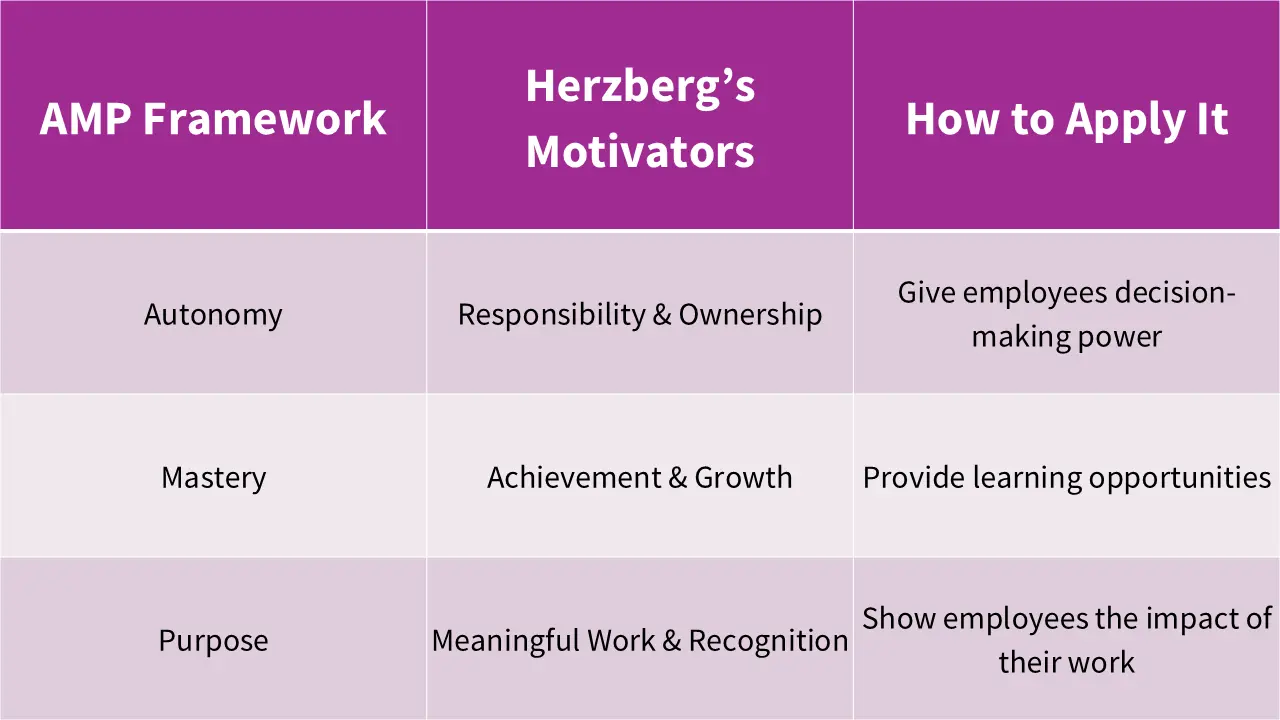Why ‘Not Unhappy’ Isn’t the Same as Motivated


Are You Preventing Disengagement—But Not Creating Motivation?
In our previous discussion on Daniel Pink’s AMP framework (Autonomy, Mastery, Purpose), we explored how true motivation isn’t just about rewards and punishments but about creating an environment where employees feel empowered, challenged, and connected to a larger purpose.
But let’s take this one step further.
Many managers unknowingly make one crucial mistake: they assume that if employees are not unhappy, they must be motivated. But “not unhappy” is not the same as being engaged.
Think about it. You might be offering fair salaries, ensuring job security, and creating a comfortable office environment—yet, your team still feels uninspired. Why? Because removing dissatisfaction is not the same as building motivation.
This is exactly what Herzberg’s Two-Factor Theory helps us understand.
Why Comfort Alone Won’t Inspire Performance
Imagine you’re running a restaurant. You invest in a beautiful dining space, high-quality cutlery, and a well-trained staff. These things prevent customer complaints, but they don’t make your restaurant the most loved place to dine. What truly draws people in? Exceptional food, great service, and a memorable experience.
The same applies to leadership. Good salaries, policies, and benefits only prevent dissatisfaction—but they don’t make employees passionate about their work.
This is where Herzberg’s Two-Factor Theory connects with the AMP framework: While Pink talks about what naturally drives people, Herzberg explains why some workplace efforts fail to create engagement despite being well-intended.
Let’s break it down.
Herzberg’s Two-Factor Theory: The Key to Unlocking Motivation
Herzberg’s theory identifies two sets of workplace factors:
- Hygiene Factors (Prevent Dissatisfaction but Don’t Motivate)
These factors act like a safety net—if they’re missing, employees become unhappy. But even if they’re present, they don’t inspire extraordinary effort.
- Salary & Perks: A well-paid employee might not complain—but do they feel excited about Mondays?
- Company Policies: Transparent policies prevent frustration but don’t make work enjoyable.
- Job Security: Feeling safe in a job keeps employees from leaving, but doesn’t make them perform better.
- Work Environment: A comfortable office prevents discomfort, but it doesn’t inspire creativity.
- Managerial Relationships: A good manager prevents workplace toxicity but doesn’t automatically create enthusiasm.
Many IT companies in India offer great salaries, healthcare, and job security, yet employees frequently switch jobs. Why? Because while hygiene factors prevent dissatisfaction, they don’t create deep engagement.
- Motivators (Drive True Engagement and Job Satisfaction)
These factors fuel passion, creativity, and high performance.
- Achievement: Employees feel motivated when their work has visible impact.
- Recognition: A simple “Well done!” can sometimes be more powerful than a bonus.
- Meaningful Work: People thrive when they feel their work has purpose.
- Responsibility & Autonomy: Having ownership over tasks creates a sense of pride.
- Career Growth: Employees stay engaged when they see a path forward.
A startup struggling with employee engagement started a peer-recognition program where employees publicly acknowledged each other’s contributions. The result? A boost in morale and teamwork—because people felt valued.
How Can Managers Apply This Theory?
As a manager, your first job is to fix the hygiene factors to remove dissatisfaction. Your second (and more important) job is to focus on motivators to build true engagement.
Step 1: Fix the Hygiene Factors First
Before expecting motivation, make sure dissatisfaction isn’t holding your team back.
- Offer fair pay, but don’t over-rely on it as a motivator.
- Ensure clear and simple policies that don’t create unnecessary frustration.
- Provide job security to reduce anxiety about layoffs or instability.
- Maintain a comfortable and positive work environment that supports productivity.
Actionable Tip: Conduct an anonymous “frustration survey” to find out what hygiene factors might be demotivating your team.
Step 2: Activate the Motivators for True Engagement
- Give Meaningful Work: Connect employees’ roles to a bigger mission. Instead of just assigning tasks, explain why their work matters.
- Recognize Contributions Regularly: Don’t wait for the annual appraisal—small, frequent appreciation makes a huge difference.
- Empower Employees with Ownership: Let them take responsibility for decisions and projects. Autonomy fuels motivation.
- Create Growth Opportunities: Offer leadership training, skill-building workshops, and mentorship programs.
- Celebrate Progress, Not Just Big Wins: Encourage a culture where learning and improvement are valued.
Actionable Tip: Implement a “Motivation Check-in” where you ask employees:
- What excites you most about your work?
- What part of your job feels the most meaningful?
- How can I help you grow in your career?
AMP Meets Herzberg
Daniel Pink’s AMP framework (Autonomy, Mastery, Purpose) aligns closely with Herzberg’s motivators.

If you’ve already started building autonomy, mastery, and purpose in your leadership, Herzberg’s theory helps ensure that hygiene factors aren’t holding you back.
Final Thoughts: From Preventing Dissatisfaction to Inspiring Greatness
Many Indian managers spend their time removing workplace frustrations—which is important, but it’s only half the battle.
True leadership is about moving beyond “not unhappy” to truly engaged.
So, ask yourself today:
- Am I only fixing problems, or am I also creating motivation?
- Do my employees just work because they have to—or because they want to?
- Am I designing a workplace that removes dissatisfaction—or one that sparks excitement?
Remember: Employees stay in jobs where they feel safe and comfortable—but they thrive in workplaces where they feel challenged, appreciated, and inspired.
Are you ready to make that shift?
In the comments below state what is that one small change you’ll implement this week to build true motivation in your team?






Responses